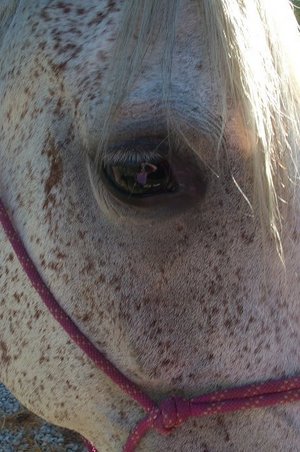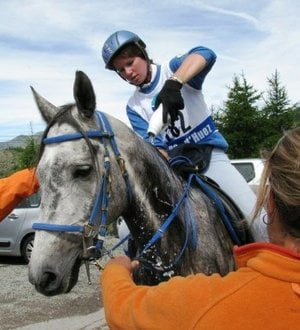So you want to be a distance rider? Are you a die hard rider who would rather ride than eat, sleep, or watch television? Then let’s explore the sport of endurance riding.
What is an Endurance Ride? Endurance riding is an extreme sport, you can enter to race at distances of 50 to a 100 miles, with finish times of 10-12 hours. There are classes for novices to enter that are 12-35 miles. These are considered Limited Distance and are called LD’s. You can race against the other horses and riders, or you can simply ride your own ride at the minimum pace by racing against the trail itself. The rides are judged, and horses will be checked by veterinarians at set check points. Your horse will be examined for metabolic issues (heart rate, pulse, dehydrations) and injuries and lameness. Horses that do not pass the veterinary examination can be pulled from the race. Horses that present a danger to themselves or others can be pulled from the race, as can riders who are disruptive or show extremely poor judgment. The key to a good experience is preparation, and plan to have fun!
What kind of horse will I need? The dominate breed if you are competitive will be the Arabian or Half Arabian. These horses were originally bred for their stamina over desert terrain. They are a tough and hardy. Not to worry though, any breed of horse is eligible to participate. The Appaloosa, Missouri Fox Trotter, Kentucky Mountain Horse, Mustang, Tennessee Walker, and many other breeds do well in the sport of Endurance Riding. You will be looking for a horse type as well as a breed. Heavily muscled horses typically are not as competitive at the sport as the lighter, leaner type of horse. For limited distance the horse must be a minimum of four years old, for distances over 25-35 miles the age requirement is six years old. You will need a sane, well trained, energetic and compliant horse.
What equipment will I need to get started? To begin you will need transportation to get you to your training rides, and the endurance competition itself. This will require a truck that can pull the other must have a horse trailer. If you will be purchasing a truck, be sure that it is heavy duty enough to pull the size trailer you plan to purchase; for further information call the dealership where you plan to purchase a trailer, or the manufacturer of your trailer for the weight of the trailer. Add to that the weight of your horse, and all equipment, feed, tack, camping gear, or other items that will be loaded in your trailer. Your truck must have the capacity to pull the poundage of all these items. The most important piece of equipment will be your riding helmet. Don’t skimp on this item as it protects your most precious organ. If you ride long enough and hard enough you will eventually have a fall. Your helmet is the only protection you have to keep you riding another day. Bones can be mended, wounds can be stitched up, but your brain will not recover from serious injury. Keep your head protected and safe! When training and competing your horse you will need a sturdy halter, a lead rope, a good fitting bridle, saddle pads, a saddle that fits both you and your horse without causing any soreness (a saddle that works for short rides may not work over long distance), a girth that fits and does not cause rubs, and a water bottle holder or two, and a sea sponge with a clip attached. You will use the sea sponge to dip into creeks to cool your horse down on long rides. A person can go crazy on equipment. Saddles prices can be as low as $369.00 up to $3000.00 each. What you pay for your saddle isn’t as important as how well it fits your horse, and you. As a beginner, start with what you have, and purchase new gear as it is warranted, as you can afford it. Make certain that all of your equipment is in good repair. Remember, fit and comfort for you and your horse are of the most importance.
You will need comfortable riding clothes. Jeans will not cut it over the long distance. Those inner seams will rub and chafe. Your fun ride will quickly become very unpleasant! Get you a good quality of riding tights, something soft and stretchy. They come with or without knee patches for better grip. A low-cost option are the tights from www.hanes.com, these are not made for riding, but are very low cost, comfortable and fit all shapes and sizes. Wear layers, undershirt, shirt, vest or jacket depending on the expected weather at your event. You can remove layers. Many riders have fun with their outfits. Some have them made from stretch lycra in fun colors and patterns. Exercise tights, biking tights, and other sports related clothing works well for the sport. Comfort is the key word for clothing.
Drink plenty of fluids. Be sure you have packed adequate fluids for both you and your horse. You will want to carry several bottles of water and drink them! Replace them at the vet checks. This will keep you from becoming dehydrated on rides. Allow your horse to drink at every opportunity on the ride. If your horse is finicky you may have to haul water from home and give it to the horse at vet checks. Some people enjoy the sports drinks that help to replenish your electrolytes. Try these during some of your longer training rides to find what works best for you. Avoid carbonated beverages!
Do you have the time to train? Training your horse for endurance takes time. You will need at least three training rides per week. It will take at least 12 weeks to prepare a mature horse for its first limited distance ride. It may take two years to prepare a horse for the first 50-100 mile race. Start off with long slow training rides, gradually over time increase the speed of the training rides. Never increase speed and distance at the same time. The easiest training method that I have found is to take the distance of the ride you plan to compete, and split that distance over three training sessions riding the horse slightly faster than you would expect to go at the ride. An example would be training for your first 25 mile LD (limited distance). 25/3=8 miles per session 3 times per week. Training rides will start out about an hour or two a night, then decrease in time, and increase in speed. So a person can easily ride this distance one evening on a week day, and two evenings on the weekend. You would start off slow until your horse can walk the distance with ease, gradually working up to a trot over many training sessions. Eventually you would trot most the ride except when the footing was dangerous, slick, or extremely hilly or rocky. Riding speed can vary from 5.5 – 9 miles per hour. To know how fast the pace is for a certain ride, contact the ride manager prior to entering. If the ride has been in existence for some time, they will have an idea of the speed necessary to complete and the speed necessary to compete.
What will it cost to enter? The entry fees for rides range from about $50.00 – hundreds of dollars depending on the distance of the ride, and if the ride is sanctioned by the AERC. You may receive a discount on your entry fee by becoming a member of the distance riding organization in your area. Check with the ride manager for entry forms, entry fees, and rules for the competition.
Training for the rider is equally important as training the horse. When entering an endurance ride, the rider must always keep in mind the possibility that an injury could cause lameness in their horse, or they could be separated from their horse. In this worst case scenario you need to be able to walk the distance to the next check point. This could be five miles or twenty miles! Many riders also dismount and tail their horse up a hill in order to save their horse from pulling up the weight of horse and rider. On nights that you do not need to train your horse, train you! Ride an exercise bike, treadmill, or get out for a brisk hike at least two times per week. You will feel better and be prepared to walk if the situation warrants.
Educate yourself by reading these books
All Horse Systems Go, by Nancy S. Lovin
Going the Distance, by Nancy S. Lovin
Ten Feet Tall, Still by Julie Suhr




